Toyohashi Plant 'Steelmaking Factory began operations in March 2015, upgrading its aging equipment to a state-of-the-art system and equipping it with a disaster-resistant supply system in the event of a Nankai Trough earthquake. We introduced a 200-ton eco-friendly high-efficiency electric furnace (ECOARC™*), one of the largest in Japan, and subsequently changed our operating method to suit the features of the ECOARC™ furnace, including controlling the atmosphere inside the furnace. By utilizing our unique technology and know-how to improve operations, we have achieved energy and cost reduction effects, leading to further reductions in electrode consumption. The steel mill has become one of Japan's top environmentally friendly and competitive Steelmaking Factory, with increased steelmaking capacity that allows it to operate solely on inexpensive nighttime electricity, and the introduction of a bloom/billet continuous caster that has made it self-sufficient in billets for steel bars bars.
*ECOARC™ is a registered trademark of Steel Plantech Co., Ltd.
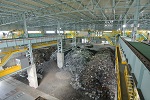
At the scrap yard, we sort and store steel scrap which is the raw material, by type. Quality is maintained by appropriately controlling the scrap mixing ratio during use.
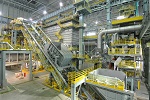
Using a computer system, optimally mixed scrap is automatically transported and charged into an electric furnace.
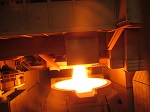
Scrap is melted by electric power and oxidation reaction heat. Impurities in molten steel are removed by oxidation refining. Electricity consumption is greatly reduced by preheating the scrap with the high-temperature exhaust gas generated during scrap melting.
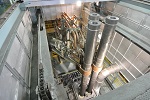
Slag-making materials and ferroalloys are added, and refining and composition adjustment are performed. We also control the temperature according to the casting conditions.
We add a small amount of elements to build higher quality steel.
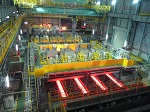
Molten steel is poured evenly from the tundish into the mold for continuous casting.

We manage inventory of blooms and billets, distribute slabs to three rolling mills for large, medium, and steel bars, and control the charging order.

